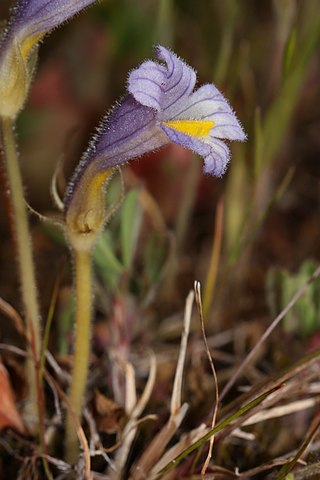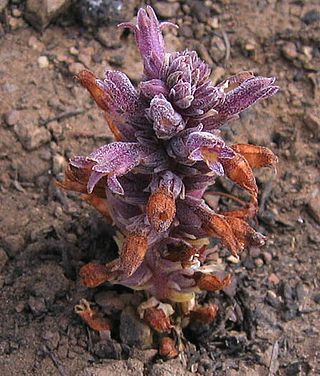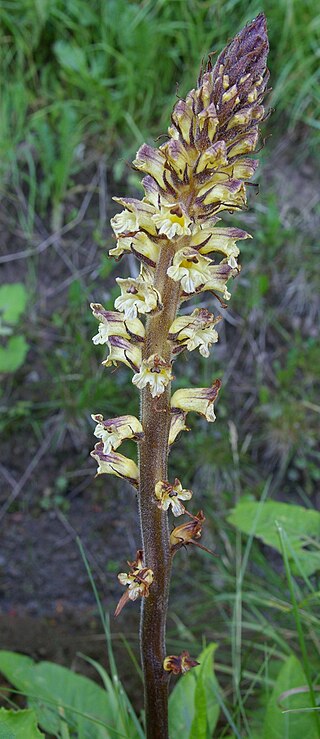
Orobanche, commonly known as broomrape, is a genus of almost 200 species of small parasitic herbaceous plants, mostly native to the temperate Northern Hemisphere. It is the type genus of the broomrape family Orobanchaceae.

A parasitic plant is a plant that derives some or all of its nutritional requirements from another living plant. They make up about 1% of angiosperms and are found in almost every biome. All parasitic plants develop a specialized organ called the haustorium, which penetrates the host plant, connecting them to the host vasculature – either the xylem, phloem, or both. For example, plants like Striga or Rhinanthus connect only to the xylem, via xylem bridges (xylem-feeding). Alternately, plants like Cuscuta and some members of Orobanche connect to both the xylem and phloem of the host. This provides them with the ability to extract resources from the host. These resources can include water, nitrogen, carbon and/or sugars. Parasitic plants are classified depending on the location where the parasitic plant latches onto the host, the amount of nutrients it requires, and their photosynthetic capability. Some parasitic plants can locate their host plants by detecting volatile chemicals in the air or soil given off by host shoots or roots, respectively. About 4,500 species of parasitic plants in approximately 20 families of flowering plants are known.

Orobanche aegyptiaca, the Egyptian broomrape, is a plant which is an obligate holoparasite from the family Orobanchaceae with a complex lifecycle. This parasite is most common in the Middle East and has a wide host range including many economically important crops.

Orobanche uniflora, commonly known as one-flowered broomrape, one-flowered cancer root, ghost pipe or naked broomrape, is an annual parasitic herbaceous plant. It is native to much of North America, where it is a parasitic plant, tapping nutrients from many other species of plants, including those in the families Asteraceae and Saxifragaceae and in the genus Sedum. The name "orobanche" can be translated to "vetch-strangler" and "uniflora" can be translated to "single-flower".

Orobanche minor, the hellroot, common broomrape, lesser broomrape, small broomrape or clover broomrape, is a holoparasitic flowering plant belonging to the family Orobanchaceae. It is one of about 150 non-photosynthetic plants in the genus Orobanche that parasitize autotrophic plants.

Orobanche bulbosa is a species of plant known by the common name chaparral broomrape.

Orobanche californica, known by the common name California broomrape, is a species of broomrape. It is a parasitic plant growing attached to the roots of other plants, usually members of the Asteraceae.

Orobanche cooperi is a species of broomrape known by the common name Cooper's broomrapedesert broomrape, spike broomrape, and burroweed strangler. It is native to the desert regions of the southwestern United States and northern Mexico, where it is a parasite growing attached to the roots of other plants, usually members of the Asteraceae, such as Artemisia, Hymenoclea, Ambrosia and Encelia. Although not usually weedy, it has been found infesting agricultural cropland, including tomato fields in inland California. This plant arises from a thick root and a scaly, twisted stem base, and produces a thick, clumpy stem up to 40 centimeters tall. As a parasite taking its nutrients from a host plant, it lacks leaves and chlorophyll. It is dark purple in color and coated with glandular hairs. The inflorescence is an elongated array of several flowers. Each flower is tubular, purple and hairy, and up to about 3 centimeters long.

Orobanche corymbosa is a species of broomrape known by the common name flat-top broomrape. It is native to western North America where it is a parasite growing attached to the roots of other plants, usually sagebrush. It produces a cluster of thick, glandular stems with enlarged bases and stout roots, the hairy stems pale whitish or yellowish, often purple-tinged, and up to 17 centimetres (6.7 in) tall. As a parasite taking its nutrients from a host plant, it lacks leaves and chlorophyll. The inflorescence is a wide array of a few tubular flowers. Each is 2 centimetres (0.79 in) or 3 centimetres (1.2 in) long, coated in glandular hairs, and dark-veined pink or purple in color.

Orobanche fasciculata is a species of broomrape known by the common name clustered broomrape. It is native to much of western and central North America from Alaska to northern Mexico to the Great Lakes region, where it grows in many types of habitat. It is a parasite growing attached to the roots of other plants, usually members of the Asteraceae such as Artemisia; and other genera such as Eriodictyon and Eriogonum. This plant produces one or more stems from a bulbous root, growing erect to a maximum of about 20 centimeters in height. The stems, leaves and five-lobed flowers are covered by sticky hairs. As a parasite taking its nutrients from a host plant, it lacks chlorophyll as well as a water-storage system. It is variable in color, often yellowish or purple. The inflorescence is a raceme of up to 20 flowers, each on a pedicel up to 15 centimetres long. Each flower has a calyx of hairy triangular sepals and a tubular corolla 1.5–3 cm long. The flower is yellowish or purplish in color.

Orobanche parishii is a species of broomrape known by the common names Parish's broomrape and short-lobed broomrape. It is native to the coast and mountains of California and Baja California, where it is a parasite growing attached to the roots of other plants, usually shrubs of the Asteraceae, such as Menzies' goldenbush. This plant produces usually one thick, hairy, glandular, pale yellowish stem up to about 26 centimetres (10 in) tall. As a parasite taking its nutrients from a host plant, it lacks leaves and chlorophyll. The inflorescence is a dense cluster of flowers accompanied by dark-veined oval bracts. Each flower has a calyx of triangular sepals and a tubular corolla roughly 2 centimetres (0.8 in) long, pale brownish or pinkish in color with red veining.
Orobanche pinorum is a species of broomrape known by the common name conifer broomrape. It is native to the forests of western North America, where it is a parasite growing attached to the roots of other plants, usually Holodiscus species. This plant has an erect stem with a wide, thickened base and slender top growing 10–30 centimetres (3.9–11.8 in) tall. As a parasite taking its nutrients from a host plant, it lacks leaves and chlorophyll and is brownish or yellowish in color. The inflorescence is a dense, spreading array of purple-tinged yellowish flowers 1–2 centimetres (0.39–0.79 in) long.

Orobanche ramosa is a species of broomrape known by the common names hemp broomrape and branched broomrape. It is native to Eurasia and North Africa, but it is known in many other places as an introduced species and sometimes a noxious weed.
Orobanche valida is a species of broomrape known by the common name Rock Creek broomrape. It is endemic to California, where its two uncommon subspecies grow in mountainous habitats separated by several hundred miles. Howell's broomrape, ssp. howellii, is limited to the North Coast Ranges north of the San Francisco Bay Area, where it grows in chaparral, often on serpentine soils. The similarly rare subspecies valida is known from only four occurrences in the Transverse Ranges. The plant is a parasite growing attached to the roots of other plants, generally shrubs; ssp. howellii can often be found on Garrya species. The plant produces a hairy, glandular purple stem up to about 35 centimeters tall. As a parasite taking its nutrients from a host plant, it lacks leaves and chlorophyll. The inflorescence is a small cluster of tubular purple flowers 1 to 2 centimeters long.

Orobanche rapum-genistae, the greater broomrape, is a plant species in the genus Orobanche. It is a parasitic plant, native to Europe, growing on the roots of plants in the bean family, usually common broom or European gorse.

Orobanche ludoviciana, the Louisiana broomrape or prairie broom-rape, is a species of plant in the family Orobanchaceae. It was first described and named by Thomas Nuttall in 1818.

Orobanche hederae, the ivy broomrape, is, like other members of the genus Orobanche, a parasitic plant without chlorophyll, and thus totally dependent on its host, which is ivy. It grows to 60 cm (2 ft), with stems in shades of brown and purple, sometimes yellow. The flowers are 10–22 mm (0.4–0.9 in) long, cream in colour with reddish-purple veins.

Orobanche reticulata is a species of broomrape known by the common name thistle broomrape. It is a parasitic plant whose host is normally the creeping thistle. It is native to the lowlands of Western Europe and Central Asia, but in the United Kingdom it is a rare and protected plant, growing only in Yorkshire, on grassland sites such as Quarry Moor.

Orobanche latisquama is a species of broomrape in the family Orobanchaceae native to the western Mediterranean Basin. It is a parasite of rosemary and probably other shrubs.

Orobanche alba, also known by its common names thyme broomrape and red broomrape, is a holoparasitic plant of the broomrape family. It parasitises plants from the mint family.



















